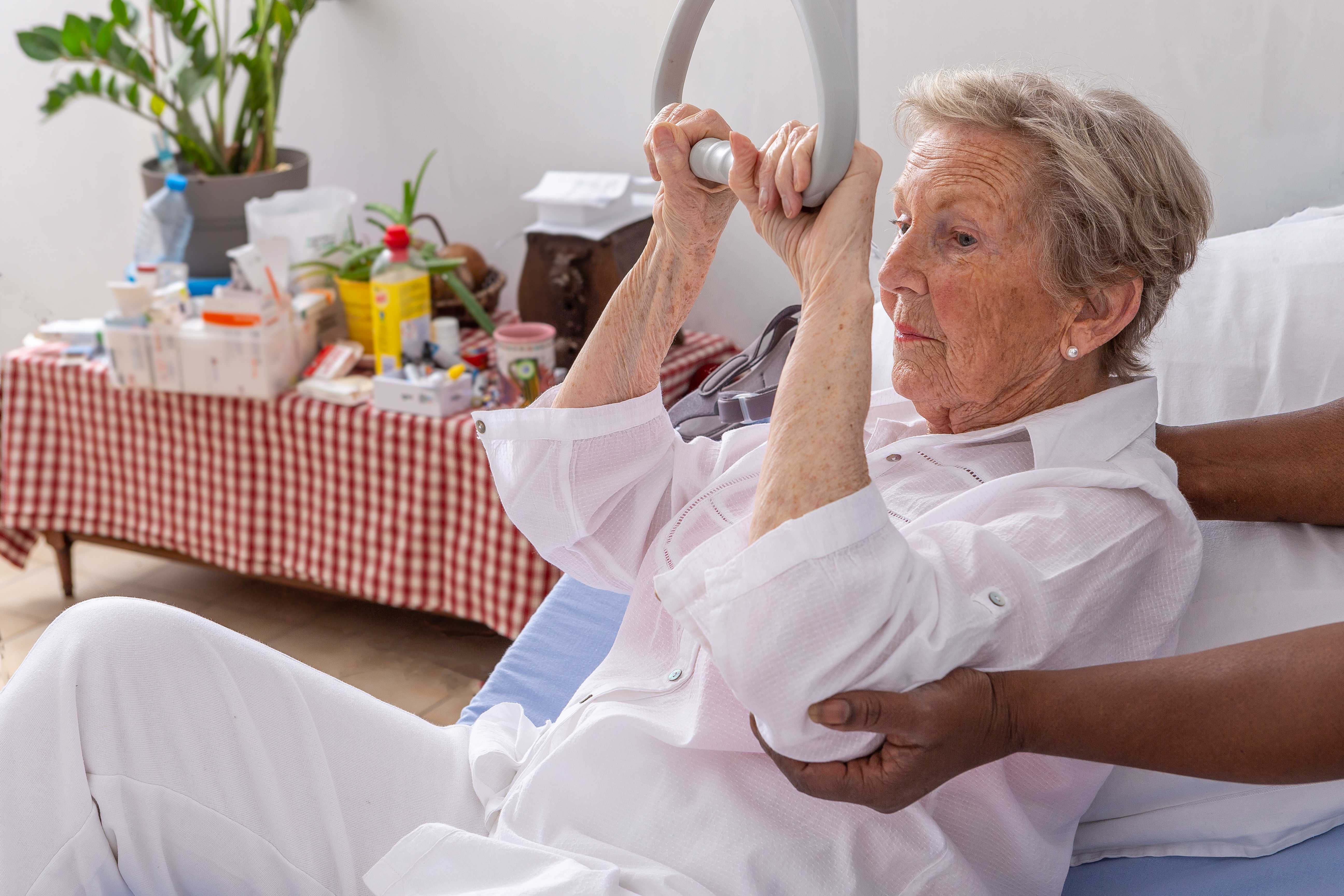
Table of Contents
It takes strength and coordination to be able to move in and out of a wheelchair from a bed, and some people need assistance. Here are some steps to help caregivers prepare for the task of transferring from the bed to the wheelchair and learn how to position themselves to avoid injury.
Safety Preparation
First, ask yourself “Am I strong enough to safely assist someone who is fragile and needs help moving by myself?”. Be honest. If you are not strong enough, get an extra set of hands to help now. Care.com has qualified at-home assistance for situations just like this.
 Find nearby help20% Off Now
Find nearby help20% Off NowLooking for extra support?
Hire an in-home caregiver to provide temporary relief or regular help with laundry, cooking, cleaning, etc., in-home helpers help lighten the daily load.
Transfer support equipment
Next, make sure you have the right equipment to do this job safely for you and the person you take care of.
Medical equipment is support for both the caregiver and ‘patient’ at home in everyday situations. There are products called ‘transfer aids’. Four products below that you can get right now:
- Grab bars are a smart addition to any bathroom. Get one here
- Get a free 12" grab bar when bundled with any shower chair from Carex
- Help getting up, around or down with a shift or gait belt
- The BeasyGlyder Premium transfer board works if the wheelchair has non-movable armrests
Checklist before you move
Review this quick list BEFORE you start the transfer of an elderly or fragile person from one place to another.
- Survey the surroundings and remove all obstacles
- Know the patient's core strength, weight, size and abilities:
- -Can they stand or bear weight?
- -Can they walk or balance?
- -Can they speak or give you cues?
- Know your strength and abilities
- Establish clear communication
- Know the wheelchair equipment and its limitations:
- -Do the brakes work?
- -Are the wheelchair hand rails fixed or are they moveable?
- -Is the wheelchair electric, transport or manual?
- Do you have additional medical equipment to help, like a shift or gait belt?
add_merchants

Transferring from Bed to Wheelchair
Step 1: Prepare for the transfer
Move the wheelchair directly next to the surface of the bed. You can opt for a slight angle of around 30-45 degrees. Lock the brakes and move any possible obstruction. Communicate clearly so you can make adjustments depending on their condition.
Step 2: Sit them up
Explain what you’re about to do clearly to the person you’re transferring so there are no surprises. Once everything is set, turn them on their side so that they’re facing the wheelchair.
Next, support their neck by putting an arm under their neck, with your hand supporting the shoulder blade. Put your other hand under the knees. Swing the legs over the edge of the bed, so they’re sitting up.
Step 3: Help them stand
First, let them scoot to the edge of the bed. Then, help them put on skid-proof socks or shoes to prevent them from slipping. Put your arms around the chest and clasp your hands behind their back. If the person is capable of standing up alone, allow them to use your body, or other apparatus, to assist their motion.
Alternatively, you may also use a transfer belt for a firmer handhold. Lean back, shift your weight, and then lift them up from the bed until their feet are firmly on the ground.
Step 4: Pivot toward the wheelchair
Continue to clasp your hands around the patient while having them pivot toward the wheelchair. If there’s another caregiver present, have them support either the wheelchair or the patient from behind.
If you have a gait belt, place it on the patient for better grip during the transfer. As they are turning, the person being transferred can either hold onto you or reach for the wheelchair for balance.
Step 5: Sit them down
As soon as their legs are touching the seat of the wheelchair, bend your knees to help lower them into the seat.
If there is another caregiver, they can help position the buttocks of the person being transferred and keep the chair stable. Reposition the foot and armrests. Lastly help them shuffle in their seat to get positioned comfortably.
Additional Help
CircleOf, is a private, secure, collaboration mobile-first app.
We are designed by and made for caregiver support. With the app in hand, caregivers manage activities of daily living (ADL) tasks, stay in communication with their care circles, privately share information, and coordinate care.
Caregiving is managing a plan as we see in the example above, there are considerations and processes for transferring a person from a bed to a wheelchair.
References
MedlinePlus - Moving a patient from bed to a wheelchair
Pivot Transfer: Wheelchair to Bed
How to make a safe wheelchair transfer - videos included

Build Your Family Care Team Today!
It’s no secret that taking care of elderly family members can be a challenging task. Not only do you have to worry about their physical and emotional well-being, but you also have to manage your busy life simultaneously.

If you’re a family caregiver, CircleOf is the app for you. It allows you to organize and collaborate with family and friends, maintain regular communication so everyone is on the same page. Download CircleOf today to build your circle of care.



